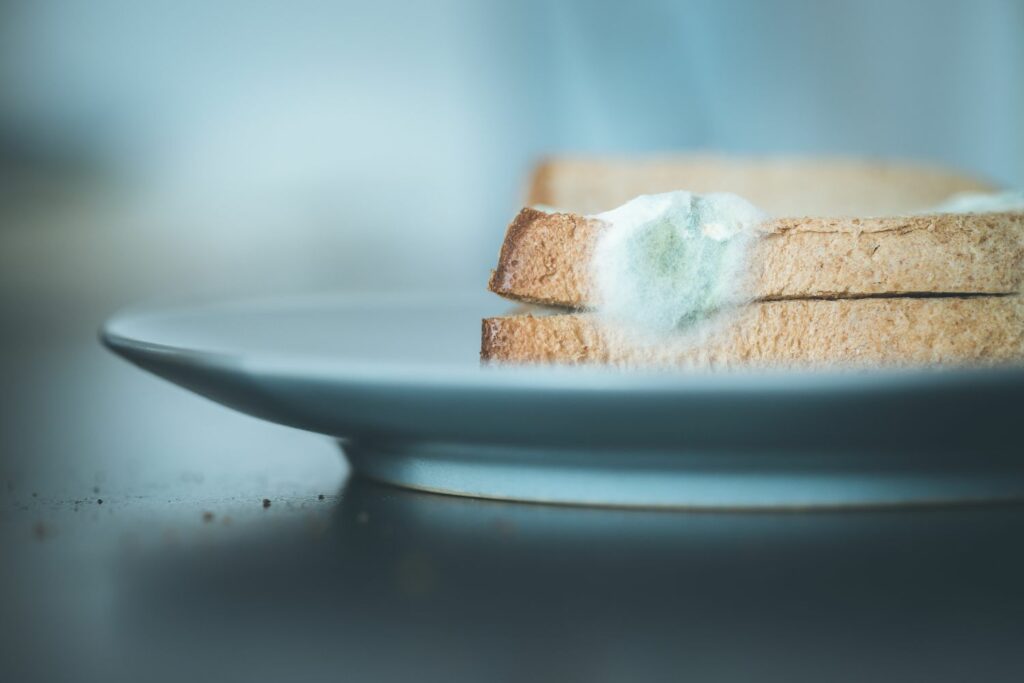What is the easiest way to recognize foods contaminated with spoilage bacteria? These days, every penny counts. You want to eat good, healthy, tasty food. You don’t want to waste leftovers, particularly when they were carefully cooked in the first place. Every working mother, father, or just regular busy person puts food into the cupboard, fridge, or freezer, and then sooner or later wonders: Is this food still good, or has it gone off? What IS the easiest way to recognize foods contaminated with spoilage bacteria?

Technically, food is spoiled in two ways: food spoilage organisms and food pathogens.
Food spoilage organisms can be yeasts, molds, fungi, or bacteria. These microscopic critters feed on the same food we eat, only they live on or grow into foodstuffs. Humans have developed great senses over the ages to spot food spoilage. Food spoilage organisms can be smelled, seen, tasted, and detected by touch. The smell of spoiled milk is a sign that food spoilage bacteria have been at work. When you see fuzzy blue spots on your leftovers, fruit, or bread, that is food spoilage, mold, or yeast eating your lunch.
Sometimes bread tastes like dirt when you bite into it. In this case, your tongue detects mold that has not yet reached the visible stage. If food smells rotten, that is probably food spoilage bacteria. When food smells sulfur, that means a protein is decaying. Of course, it is probably ok if an excellent fresh egg is overcooked when hard-boiled and smells like a whiff of sulfur. Next time add a bit of white vinegar to the water when boiling.
Visually, food can change color when spoiled. To the touch, spoiled food can feel slimy compared to how it feels when fresh.
The good news is that food spoilage organisms like mold and/or bacteria might turn your stomach, but they usually will not make you sick. Your body is designed to detect problems, just spit them out or throw them away. Usually, no serious problem will occur from food spoilage bacteria or other organisms.
Food pathogens, on the other hand, can make people very sick. Food pathogens include bacteria, but also viruses and parasites. Food pathogens often come along with food spoilage, so throwing out suspect food helps avoid them. Famously, other food pathogens, like E. Coli bacteria, cannot be seen, smelled, or tasted.
In both cases, the best defense is a good offense. Modern food safety handling procedures have come a long way. Our food often comes in sealed packages and has been sterilized at the factory. Fresh fruits and vegetables should always be washed before eating. Meat should be well cooked. Hot foods should be kept hot (over 140 degrees), and cold foods should be kept cold (under 40 degrees) after two hours of regular storage. Don’t mistreat foods to allow cross-contamination. E.g., always wash a knife used to cut raw meat before using it to cut fruit.
Some people like to label leftovers to remember how long they have been in the fridge. Generally, throw out anything a week or sooner once it is opened.
FAT TOM
Universities have developed an acronym to help remember the basics of safe food handling, capturing the principles built over centuries. This mnemonic is FAT TOM. Which stands for Food, Acidity, Time, Temperature, Oxygen, and Moisture. What you are supposed to remember is this:
Food is eaten by food spoilage bacteria, just like we eat food.
Acidity: anything pickled is in a highly acidic environment and can safely last. Low ph foods like ketchup do not need to be refrigerated.
Time: bacteria grow quickly on many foods unless the temperature is under 40 degrees or over 140.
Temperature: many foods like meat need to be cooked to a specific temperature to be safe. Generally, food reaching 165 degrees internally for 30 seconds will kill bacteria.
Oxygen: bacteria need oxygen to survive. Food adequately prepared and stored in cans, sealed containers, refrigerators, breadboxes, etc., will last longer.
Moisture: Foods that can be kept dry last longer, like beef jerky. The higher the water content a food has, the easier it is to spoil.
Another simple statement of basic food safety rules that restate FAT TOM is Clean, Separate, Cook, and Chill. Other safety tips include using thermometers to check food prep and storage accurately. Beware coolers that are not cool! Reheat leftovers to 165 degrees.
How to recognize foods contaminated with spoilage?
So, what is the easiest way to recognize foods contaminated with spoilage bacteria? Trust your senses: sniff, look and touch, then feel, then taste. But to be entirely safe, remember FAT TOM, and once a week, clean that fridge out!
Related posts
- How to sanitize a table used for preparing food?
- How to tell if broccoli is bad?
- How long do hot dogs last in the fridge?
- How to tell if asparagus is bad?
- How to tell if salmon has gone bad?
- What is the easiest way to recognize foods contaminated with spoilage?
